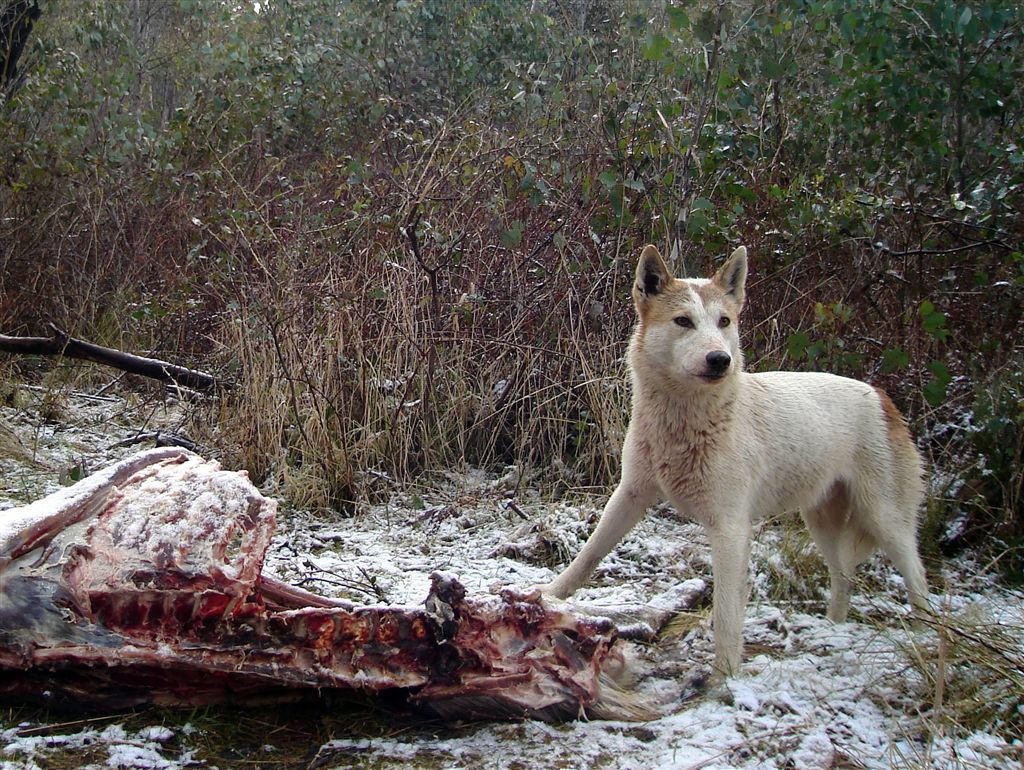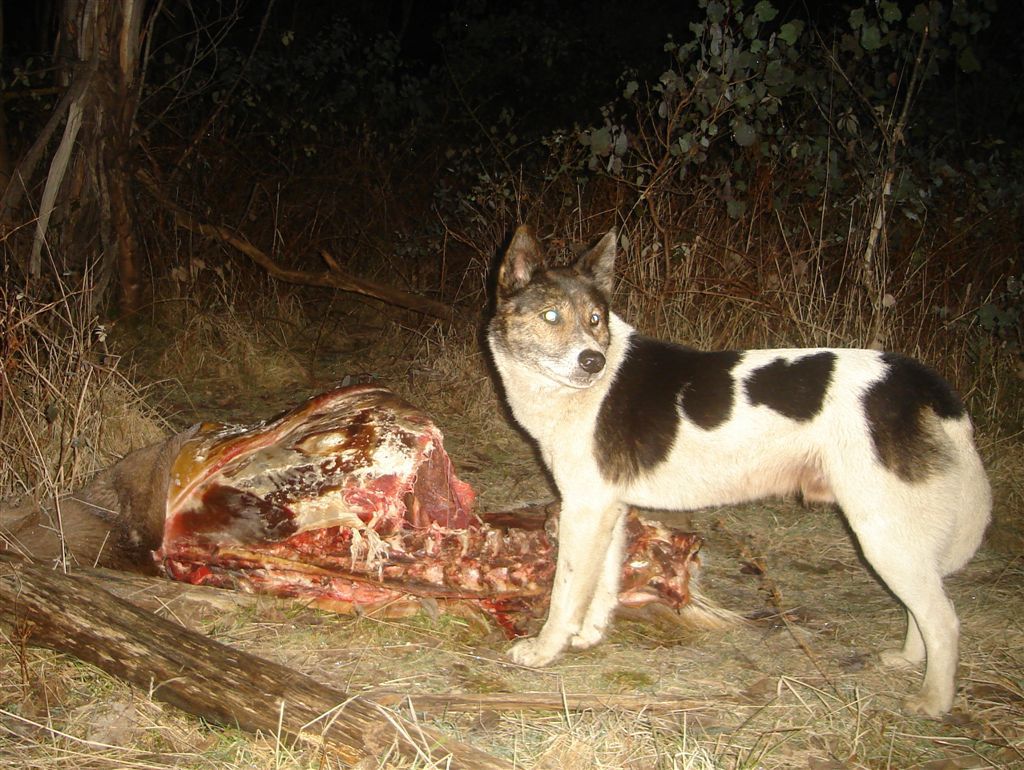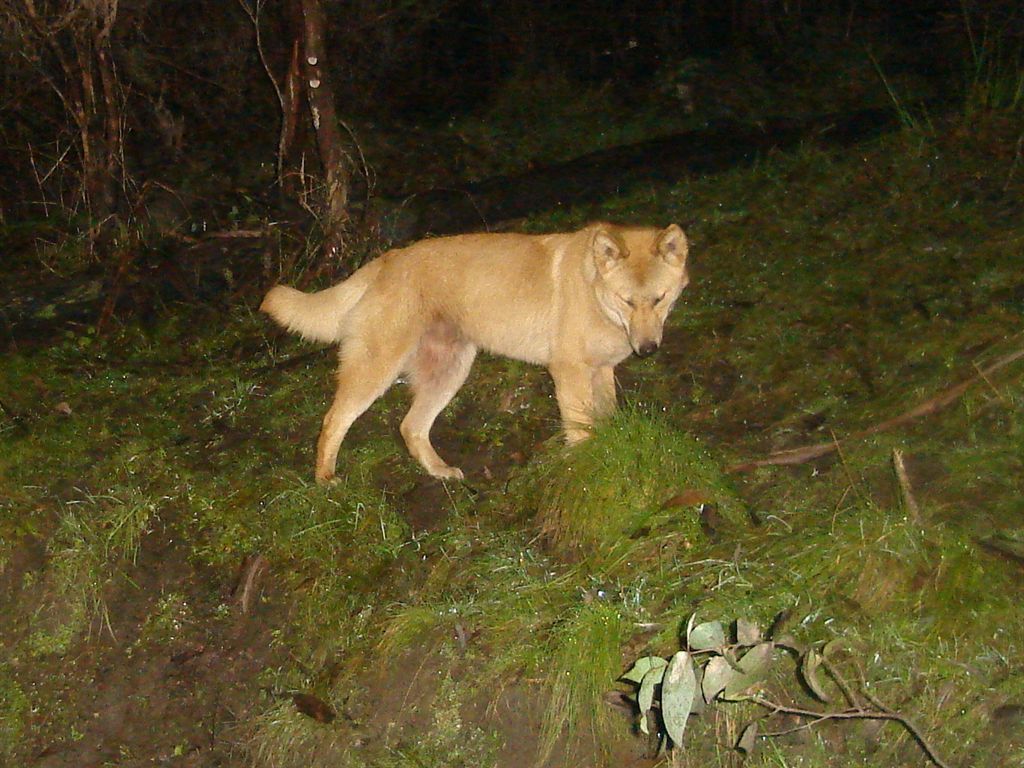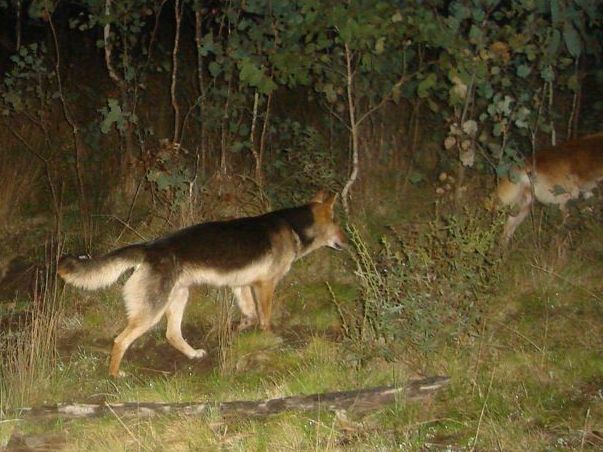Forum rules
The place for bushwalking topics that are not location specific.Re: Wild dogs?
Mon 11 Feb, 2013 5:48 pm
cdg wrote:
Its a genuine question. Baiting kills native animals. Is there an acceptable loss level?
The dingo kills native animals. Is this acceptable?
cdg wrote: I think the native wildlife of any area would be thankful that ferals have been removed.
Foxes are most appreciative of your efforts in shooting out the dogs. Rabbits support the removal of the cat.
Cheers
Re: Wild dogs?
Tue 12 Feb, 2013 9:55 am
In Vic. government departments use 3 main strategies to target the wild dog/dingo : 1080 poison laid in the form of a buried meat bait, trapping by DSE/DPI staff using leg-hold traps & snares & shooting both by Govt. pro shooters, land holders and recreational hunters on private and public land. Most govt-funded efforts are in problem areas where wild dog predation on stock is an on-going issue and 1080 & trapping is generally done in these situations targetting specific locations that have issues with dogs killing stock. Wider 1080 baiting and trapping is also done in bushed areas fringing private land to target dogs as they come into farm-land areas as well as seasonal trapping and baiting in more remote locations in state forests and some Parks. 1080 baits are buried and they need to be dug-up by the animal and consumed but obviously they are not target-specific and other native carnivors or large birds can and do eat these baits with fatal results. Bi-kill of animals & birds feeding on a 1080 kill carcass is also a significant factor and would account for many small meat-eating native animals and our scavenging birds like crows, currawongs, hawks, eagles and owls. Fortunately last year public pressure put an end to the Vic Govt's plans for large-scale aerial 1080 baiting for wild dogs in lots of the high country on the potential bi-kill on non-target species so it's hoped that this sort of program never sees the light of day again as it had the potential to decimate many small mammal/marsupial and bird species throughout these extensive drop-zones.
Personally....I get a buzz out of seeing or hearing a dingo or two while I'm off in the mountains hunting and I've never had any issues with them despite having plenty of close encounters including several howling away one night 20m from my backpack camp while I watched them in the beam of my head-torch. These are the alpha predator of the mountains and I think our bush would be a lesser place with them not there but I certainly acknowledge that wild dogs and dingos around settled areas are another thing entirely and their predation on stock causes severe financial loss and distress to many hard-working farmers year in and year out. These dogs are often very human-savvy and hard to trap, poison or shoot and despite increases in funding, staff and bounty incentives for farmers and recreational hunters to target wild dogs their numbers and their killing of stock seems to be on the increase. Just my 2 bob's worth on this anyway. Cheers
sambar358
Re: Wild dogs?
Tue 12 Feb, 2013 6:04 pm
Secondary poisoning has been demonstrated to kill individual non-target animals but no data are available demonstrating that such poisoning can cause significant reduction in population sizes of native species.
...
The available research has provided no convincing data that show significant declines [of native species] at a population level.
And conclude:
In view of the above the Scientific Committee is of the opinion that ‘1080 poison baiting used for the control of vertebrate pest animals’ is not eligible to be listed as a Key Threatening Process in Schedule 3 of the Act as there is currently no substantive evidence that, in NSW:
(a) it adversely affects threatened species, populations or ecological communities, or
(b) could cause species, populations or ecological communities that are not threatened to become threatened.
http://www.environment.nsw.gov.au/deter ... ionKTP.htm
The Queensland DPI claims:
Fluoroacetate occurs naturally in about 35 species of Australian plants, such as Acacia georginae (gidgee), Gastrolobium spp. (heart leaf poison bush) and Oxylobium spp. (box poison bush). Consequently, native animal species are generally less susceptible to fluoroacetate than introduced species.
...
There is considerable variation in susceptibility between species of animals. Dogs and foxes are the most susceptible of all animals to 1080. In general, birds show considerably more resistance than mammals. Cold-blooded animals such as reptiles and fish are the most resistant.
...
One of the risks of 1080 use is the leaching of the 1080 from the impregnated baits due to rainfall. If an area were heavily poisoned using 8 kg of 6 mg wild dog baits per hectare (containing 48 mg of 1080 per kg of bait), and all of this was leached out due to 50 mm of rain, an individual person would need to drink 169 271 L of contaminated water before receiving a lethal dose.
...
If a hunter shot a 60 kg feral pig that was in the latent period following ingestion of 3 kg of 1080 bait (at a rate of 1152 mg 1080/kg), and based on the unlikely assumption that half the ingested poison has become evenly distributed through the carcass, that hunter would need to eat 36.1 kg in one sitting before being at risk.
...
1080 is water-soluble and is readily broken down by naturally occurring bacteria and fungi. It therefore does not cause a build-up of toxic residues in soil, water or plants, nor does it bioaccumulate in organisms.Australia’s native mammals, birds and reptiles have developed much higher tolerance to 1080 than introduced animals, due to their evolution with naturally occurring 1080 in some native plants. The dose rates used in declared pest animal control, coupled with responsible baiting practices, mean that the chances of killing native animals are minimised.
http://www.daff.qld.gov.au/documents/Bi ... 80-PA5.pdf
Cheers
Re: Wild dogs?
Wed 13 Feb, 2013 11:49 am
Just one reason why is that on a recent walk I seen 2 rabbits in a area I totally wouldn't of expected and i thought to myself had i been lost or just plain starving I would have a real go at catching those varmits but it would be a cold day in hell the day an old Tom graced my Billy in the bush.
Re: Wild dogs?
Wed 13 Feb, 2013 2:57 pm
Take inspiration from the World famous cat hater John Wamsley, and try the cat stew:
The meat should be diced and fried until it is brown. Then lemon grass is to be added along with salt and pepper and three cups of quandong
It is recommended that the dish be left to simmer for five hours before being garnished with bush plums and mistletoe berries.
http://news.bbc.co.uk/2/hi/asia-pacific/6974687.stm
I look forward to your review.
P.S. the pelt can be used to make a hat.
Cheers
Re: Wild dogs?
Wed 13 Feb, 2013 9:07 pm
if there was a bounty on feral cats i would have been happy! i must have despatched hundreds with an old .177 ackley, the same gun i used on foxes. sold to mr howard and turned into rebar.
dingos dont generally denude an area of its mammal population, unlike feral dogs and cats. dingos will stalk you as well. i think they are very curious animals. the most curious animal (aside from thieving possums) ive seen while out bush was a cow that stuck its head in my tent early one morning! id heard something large moving and had assumed wombat. i almost had an early 'trip to the slit trench' in my sleeping bag.
Re: Wild dogs?
Wed 13 Feb, 2013 10:41 pm
cdg wrote:It is interesting that leg hold traps and snares are still used. I was under the impression they were illegal. i got rid of old rabbit traps years ago. no doubt these are some form of govt approved humane snare.
Info on the approved leg hold traps. They are different from the old rabbit traps. I've still had pets brought in with broken legs from them though, and ones which have become necrotic and gangrenous, necessitating amputation. I've also treated animals which have chewed off their own leg which has been in a trap.
http://www.dpi.vic.gov.au/agriculture/p ... ghold-trap
Re: Wild dogs?
Thu 14 Feb, 2013 1:55 pm
sambar358
Re: Wild dogs?
Fri 15 Feb, 2013 10:31 pm
Re: Wild dogs?
Wed 20 Feb, 2013 9:44 pm
Re: Wild dogs?
Sun 03 Mar, 2013 10:33 pm
Re: Wild dogs?
Mon 04 Mar, 2013 6:53 am
puredingo wrote:On quick little 40 minute romp not more than 10 minutes from my house I encountered 2 seperate mobs of deer, a mob of 6 goats and a fox (in the middle of the day?) Now if i were allowed to carry a measly little .22 mag there would be no need for any traps at all!
thats irresponsible talk.
do you have any idea how hard it is to kill deer cleanly with a .22, its illegal to hunt deer with a .22 in nz because of that reason, even with a .223 you can have problems
you end up having to fire more shots at a target that will be moving fast if you havent killed it with the first shot, its just dangerous for anyone anywhere near the area let alone the animal...
chances are the deer runs off and you never see it again, maybe it dies a lingering death or it manages to survive.
.22 is for small animals. I wouldnt even try using one on a goat.
Re: Wild dogs?
Mon 04 Mar, 2013 10:00 am
Wayno, in the right hands a .22 can knock off a water buffalo, the biggest mistake a rifle owner can make is under estimating the abilities of the humble .22. A lot of "survivalist" rate the .22 as their prefered rifle for a list of reasons, and I think it's even the snipers calibre of choice also.
I recently was asked to put down two dairy cows suffering from eye cancer...2 shots, 2 dead beasts. I realise a cow isn't a deer and isn't quiet as flighty but any decent kind of hunter can put himself into a position where the shot is going to one of conscenquence.
Anyway I'll stop praising the virtues of the .22 and ask you this, with amature hunters entering the national parks what would get your heart racing more out on the trail, the sound of a .22 cracking away or the BOOM of a 308 thundering nearby?
Re: Wild dogs?
Mon 04 Mar, 2013 10:08 am
i dont have any choice in nz, the parks are pretty much free fire zones... so i either put up with it and go bush walking or quit bush walking,
I dont really give it a second thought....
during the roar i expect to hear guns going off regularly...
bushwalkers dont tend to get shot at, hunters do, i dont tend to hunt
Re: Wild dogs?
Mon 04 Mar, 2013 1:12 pm
There is no doubt that both the dingo and wild dogs in a farm situation can be equally destructive and a few dogs can do some serious damage to a flock of sheep or pick-off many young calves in a night and once dogs start killing domestic stock they'll usually continue as they are easier to catch and kill than their usual bush-tucker of course. I've never had any issues with my encounters with wild dogs and dingos while hunting or camped in the bush although I have had the odd nocturnal visit when I've been in the tent and often have them howling close-by at night which I really enjoy. I think people are more at risk from the semi-tame dingos of places like Fraser Island and Uluru where the dogs get fed by tourists and become used to people and loose their nautral cautiousness. In a remote bush situation a typical wild dog/dingo encounter would be a brief view of "the south end heading north" rather than the popular view of a full frontal attack with fangs barred& looking to have someone for dinner !
The two dogs pictured below were taken on one of my trail cameras last winter on a sambar deer kill in a remote part of the Alpine NP. While neither have the typical coloration of what some would regard as the pure dingo both have the typical physical characteristics of the alpine dingo but each would have some domestic dog influence somewhere in their genes as would most these days I suspect. An interesting topic....but I wouldn't let being eaten by a wild dog put you off a good day in the bush.....but what's life without a bit of excitement anyway. Cheers
sambar358


Re: Wild dogs?
Mon 04 Mar, 2013 6:31 pm
Re: Wild dogs?
Mon 04 Mar, 2013 7:23 pm
These are the two typical alpine dingo colorations : the yellow/white and the black/tan so these dogs are true-to-type coat-color wise from my experience and both have the other typical apline dingo characterists of the large broad head, quite tall muscular frame and the bushy tail. These dogs were in pretty remote areas of the Alpine National Park in Victoria and obvioulsy snapped at night when they are most active hunting. As an aside....in the ANP licenced hunters are permitted to only shoot sambar deer which are a declared game species....we are not permitted to shoot feral animals at all...so any feral cats, wild dogs, foxes etc encountered are taboo for us in the ANP. Cheers
sambar358


Re: Wild dogs?
Tue 05 Mar, 2013 8:00 pm
sambar358 wrote:... the carcass of a sambar hind that I shot last winter and after lugging-out all the usable venison...
I should imagine this is a fairly standard practice?
sambar358 wrote:....we are not permitted to shoot feral animals at all...so any feral cats, wild dogs, foxes etc encountered are taboo for us in the ANP.
But you are allowed to feed them up?
How does this sit with the argued benefits of recreational hunting on reducing feral populations.
Professional hunting and pay on the carcass I can understand.
Re: Wild dogs?
Tue 05 Mar, 2013 10:12 pm
The "professional shooter" argument is often used to counter the efforts of the recreational hunter....but would the pro-shooter on foot culling deer, goats, pigs or whatever be required to remove from the bush totally the carcass of each of his kills ? Obviously not....it would totally defeat the purpose of what they're doing in there....trying to reduce the numbers of a problem feral animal. So the pro-shooter would kill as many as he could and leave them to rot as high tallies are their aim. Do helicopters doing aerial feral animal control land beside every kill carcass and sling it out of the bush whole so the feral dogs, cats and foxes don't get a free feed ? Obviously not...impossible, impractical and down-right dangerous.....aerial feral animal control is all about shooting as many animals per flying hour as possible....missed shots, finsihing off wounded animals and confirming kills is secondary when the thing you are flying costs the government a fortune to keep in the air. Animals are shot and left....that's how it is.....and this is "pro shooting".....warts and all.
I don't really want to buy into the NSW Hunting in Parks situation once again....I've had some input into that on another thread some time ago. Our situation in Victoria hunting sambar deer in the Alpine National park is quite different and doesn't transpose onto the NSW Park model. As I mentioned earlier....in the ANP hunters are only permitted to hunt sambar deer which have the status of a Game animal in Victoria and they are legislated as such...so that sets them aside from our "ferals"....wild dogs, cats, foxes, goats & pigs. In the Alpine National Park (and other Parks that allow seasonal sambar deer stalking) licenced hunters are only permitted to hunt sambar deer....no feral animals at all. This is a Regulatory requirement of our access for hunting in Parks....deer only....no ferals ! This is probably why in Victorian Parks open to sambar deer hunting anyway, that most other user groups are unaware of our presence as they hear no shots, they see no or few hunters and usually they don't see the deer. Yet sambar deer stalking has been a part of the many portions of the Alpine Nationa Park for over 25 years and prior to the declaration of the Park sambar deer hunting had been a major activity for 50 years or more and the sambar of course have been there for over 100 years !
So realistically in the Victorian Alpine National Park and other "hunting" Parks deer hunters are unable to have an impact on feral animal numbers simply because we are not permitted to shoot feral animals under our legislated access conditions to these Parks. The NSW "hunting in Parks" situation is obviously quite different to what we have here in Victoria so any comparisons are not really valid in regard to what may or may not be the situation in some NSW Parks in the future. Hope this has clarified a few points that you made in your post. Cheers
sambar358
Re: Wild dogs?
Wed 17 Jul, 2013 11:59 am
Re: Wild dogs?
Wed 17 Jul, 2013 8:24 pm
Re: Wild dogs?
Wed 17 Jul, 2013 11:28 pm
Re: Wild dogs?
Fri 19 Jul, 2013 7:35 pm
Re: Wild dogs?
Wed 21 Aug, 2013 7:56 pm
Noticed this story on the advocate website. The other dogs on the ute tray must be stressed.
Beef farmer Adrian Hobbs has been living in the Tallangatta Valley Victoria for two years and has only seen a couple of wild dogs in that time.
But the killing of a prized working dog will make him more vigilant around the property, particularly with his two young daughters.
His dog, Neville, was killed just 400 to 500 metres from his family home, near the carcass of a dead cow.
“It is a bit concerning when they are coming down that far,” Mr Hobbs said yesterday.
“You hear them howling at night all the time.”
Mr Hobbs runs 2000 wagyu cattle on the property he manages 30 kilometres up the valley.
He has had few problems with wild dogs, unlike sheep farmers in the valley.
Electric fencing on the property is mainly internal and there is little on the bush boundary to deter the entry of the savage killers.
Mr Hobbs made the gruesome discovery of his prized working dog, dead after a savage attack, on Monday.
He had moved a group of cattle on Friday and found a dead beast in the paddock where they had been grazing.
He had decided to shift it on Monday because he was away at the weekend.
When he got home on Sunday afternoon, Mr Hobbs let his three dogs off for a run and they slept in a shed overnight.
They barked during the night but he told them to quieten down and there was no more noise.
When Mr Hobbs went out in the morning, Neville was missing.
When he hadn’t returned after a couple of hours, Mr Hobbs decided to go looking, and found Neville just 30 metres from the carcass.
The dog had been badly mauled and was dead.
Mr Hobbs said the carcass had been almost completely eaten and there were dog prints “everywhere”.
A neighbour had reported that he saw a big, yellow dog eating the carcass on Saturday afternoon.
Mr Hobbs said there were some nights when his dogs “go off” with their barking when there is something around.
“I just put it down to foxes,” he said.
But he now realises it may be wild dogs.
“At the moment, I have cattle calving. Only last week I brought them down closer to the house,” he said.
A report on the killing of his dog will be made to the Department of Environment and Primary Industries
Re: Wild dogs?
Fri 23 Aug, 2013 9:32 am
Re: Wild dogs?
Fri 23 Aug, 2013 10:48 am
Both near the suburbs and out through Kanangra.
Very creepy at times if out solo.
Its only a matter of time till someone , most likely a child, is killed.
John
Re: Wild dogs?
Fri 23 Aug, 2013 6:04 pm
Re: Wild dogs?
Wed 28 Aug, 2013 7:24 pm
You can see more on this story and the release of a draft national Wild Dog Action Plan on 7.30 tonight.
http://www.abc.net.au/news/2013-08-28/d ... er/4917640
At times I have 180-200 traps set and I know where every one is. It's all GPS-ed up here," says Don Sallway, tapping his head. "I have around seven million acres stored away."
Don is a dogger - a dog trapper - and he's the top dog in his field.
Don Sallway sits in his ute on a property in south-west Queensland.
During his 20-year career trapping wild dogs on properties throughout south-west Queensland, the 52-year-old has regularly caught twice as many dogs as his nearest rival.
When Don has finished laying a trap, it's impossible to tell he's been there.
Several years ago, after laying traps on another property, a tractor and 4WD drove through and busted them all.
"They told me they couldn't see the traps. What were they expecting? A cage and a dish of milk?"
Don is a hired gun, working for property owners who form a syndicate and contract his services.
Each contract lasts between two and three months and he is paid per kill, the cost of which is split between the local shire council and the syndicate.
Don has averaged over 600 kills for the past few years and, at $500 per dog and $100 per puppy, it seems good money.
Considering he is the best dogger by a country mile, he could easily ask for double that but he has been charging the same his entire career.
And he works hard for his money.
Re: Wild dogs?
Thu 29 Aug, 2013 12:43 pm
Re: Wild dogs?
Thu 29 Aug, 2013 1:55 pm
© Bushwalk Australia and contributors 2007-2013.
